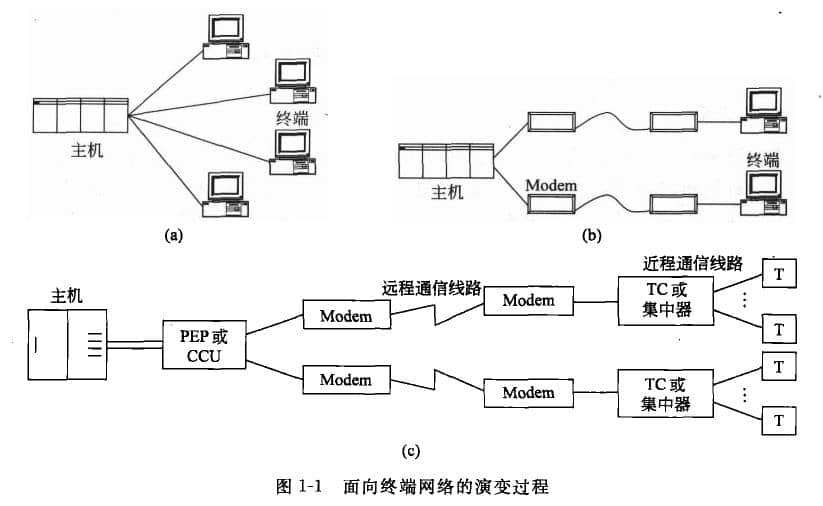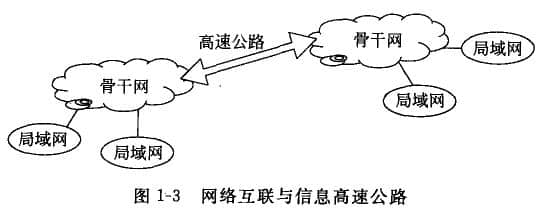The Evolution of Computer Network
Source: Shangpin China |
Type: website encyclopedia |
Time: 2015-06-18
Reviewing the development process of computer network, computer network has gone through the stages from simple to complex, from single host to multiple hosts, from communication between terminals and hosts to direct communication between computers. Its development process can be roughly divided into the following four stages.
1. Phase I: Terminal oriented network
As early as the early 1950s, the terminal oriented network was also the simplest computer network. Its composition was to directly connect a host system with multiple terminal devices through communication lines, as shown in Figure 1-1 (a). The host is the center of the network, and local users share host resources through their own terminal devices. This was the online terminal system with a single host as the center at that time. At that time, its terminal equipment did not have the ability to independently process data and could only complete functions such as input and output. All data processing and communication tasks were completed by the central host.
At this stage, computer technology and communication technology laid the technical foundation for the birth of computer networks. For example, as early as the early 1950s, the semi-automatic ground air defense system established by the United States was to collect the information of ground radar and other measurement and control equipment through communication lines to a central computer for processing, It initiated an attempt to combine computer technology with communication technology. The network characteristics, problems and evolution process at this stage are as follows.
Network features: share host resources.
Existing problems:
(1) The host is heavily loaded, so the host is responsible for both communication tasks and data processing. (2) Low utilization rate of communication lines. (3) Network reliability is poor.
Evolution process: With the increase of network users, there is a demand for remote users to pick up people on the network. The remote user connects with the host remotely through the existing telephone communication network and shares the resources of the host. Among them, the receiving equipment provided by the network is Modem, and the network development has evolved from Figure 1-1 (a) to Figure 1-1 (b). At this time, the host should not only serve local users, but also serve remote users.
With the gradual increase of remote users, in order to improve the utilization rate of communication lines, terminal control (TC) or concentrator device (CD) and other devices are introduced at the end of the network to collect data from the terminal to the host and distribute data from the host to the terminal. In order to reduce the burden of the network host, the front end processor (FEP) or communication control unit (CCU) is introduced in the front section of the network, which is specially responsible for the communication control with the terminal. The network development has evolved from Figure 1-1 (b) to Figure 1-1 (c). At this time, the division of data processing and communication control appears for the first time, The host is free from the heavy communication control, so as to give better play to the data processing capacity of the host.
2. Phase II: Internal communication oriented network
In the first stage, the network can only communicate between hosts and terminals. Each host and the terminals it serves form a subnet, and each subnet is independent of each other. In the second stage, in the mid-1960s, the network developed into an interconnected system of multiple hosts, realizing the communication between "hosts", as shown in Figure 1-2 (a), The communication between subnets served by each host is to forward data through direct connection between their hosts. The network characteristics, problems and evolution process are as follows.
Network characteristics: multi host oriented. The network structure has changed from "host terminal" to "host host". Existing problems: the network system and network products of each enterprise at this stage are relatively independent, and there is no unified standard. At this time, the network can only serve for internal enterprises.
Evolution process: With the increase of communication volume between subnets, the communication network in which the host is responsible for data forwarding appears to be powerless. Therefore, a new network device has been developed, namely, the Communication Control Processor (CCP), which is responsible for communication control between hosts, separating host work from communication tasks. Network development is shown in Figure 1-2 (a) Evolving to Figure 1-2 (b) When the network developed to this point, the concept of two layers of network was formally proposed, that is, the network consists of communication subnet and resource subnet. Communication subnet: It is composed of communication control processor, communication line and other communication equipment connection, responsible for network communication, and completing network data transmission, forwarding and other information processing tasks.
Resource subnet: It is composed of many host systems, terminals and various peripheral devices. Be responsible for the generation and processing of network data, and provide network resources, network services and other functions to network users. With the expansion or extension of the network application scope, the communication subnet extends from the private communication network within the enterprise to the use of social public communication networks (such as PSTN telephone network, X. 25 packet switching network, etc.). At this time, the development of the network evolves from Figure 1-2 (b) to Figure 1-2 (c). Then another new network interface device was developed, namely, the interface message processor (IMP). The main function of this device is to exchange and forward data at the communication subnet interface based on the store and forward principle.
Major event: By the end of the 1960s, an experimental network named "Advanced Research Project Agency Network" (ARPANET) was funded by the Advanced Research Projects Agency of the US Department of Defense. The ARPANET network connects the hosts of four universities located in different geographical locations in the United States (University of California, Los Angeles, University of California, Santa Barbara, Stanford University, University of Utah), carries out decentralized control and resource sharing, uses specialized communication control processors, and uses packet switching technology to transmit information, The communication protocol it tried is the main part of TCP/IP protocol popular on the Internet today. The emergence of ARPANET is of historic significance for the emergence and development of the Internet in terms of network concept, network communication protocol, network architecture and network design.
3. The third stage: heterogeneous computer interconnection network
In the 1970s, computer networks gradually became popular, and major computer companies successively launched their own network architecture and corresponding network products (including software and hardware). For example, IBM launched its own System Network Architecture (SNA) in 1974, and in 1975, DEC launched T's own digital network architecture (DNA). At that time, only the network products of IBM could be used for the network built according to the SNA network architecture, and only the network products of DEC could be used for the network built according to the DNA network architecture. That is to say, the computer network owned by various companies at that time was a "closed" network system, and the network products applied by them were independent of each other.
The third stage of network development was in the late 1970s or early 1980s. In this stage, it is mainly reflected in how to build a standardized network architecture, so that the network systems of different companies or departments can be interconnected, mutually compatible and increase interoperability, and realize the maximum sharing of computer network resources among companies or departments.
How to realize the interconnection of heterogeneous network architectures and promote network standardization is a gradual process. At that time, it was roughly divided into two steps.
Step 1: Realize mutual compatibility or standard unification of the network architecture of each company or department. Step 2: launch international network architecture standards as soon as possible.
In 1977, the International Organization for Standardization (ISO) established the "Open Systems Interconnection Sub Technical Committee" under the "Computer and Information Processing Standardization Committee", which is dedicated to developing a series of international standards for open systems interconnection.
In 1983, ISO launched an international standard framework of "Open System Interconnection/Recommended Model (OSI-RM)". The model is divided into seven layers, and the functions of each layer are specified in detail under the standard framework to achieve interconnection, interoperability and application portability in the open system environment. Since then, the network products of network companies have been based on a unified standard, and the interconnection of various heterogeneous networks has a network architecture framework for reference.
4. The fourth stage: network interconnection and information off highway
In the 1990s, with the rapid development of computer network technology, especially the establishment of the National Information Infrastructure (NII) in 1993 in the United States, many countries have also formulated and established their own NII, which greatly promoted the development of computer network technology and made the network become the backbone of countries around the world Website construction See Figure 1-3 for the development stage of backbone network interconnection and information superhighway The so-called "information highway" is an information transmission network system with high speed, large capacity and multimedia.
The construction of information superhighway is to make use of digital large capacity optical fiber communication network to make all network equipment of government institutions, information media, universities, research institutes, hospitals, enterprises, even offices, homes, etc. networked. At that time, people's needs for food, clothing, housing, transportation, work, medical care, and other living needs can be remotely controlled through network clicks, At the same time, in this stage, the network will also provide mankind with more abundant information resources and entertainment programs than television and telephone. Information resources have been greatly shared, allowing users to have more free choices.
Source Statement: This article is original or edited by Shangpin China's editors. If it needs to be reproduced, please indicate that it is from Shangpin China. The above contents (including pictures and words) are from the Internet. If there is any infringement, please contact us in time (010-60259772).









